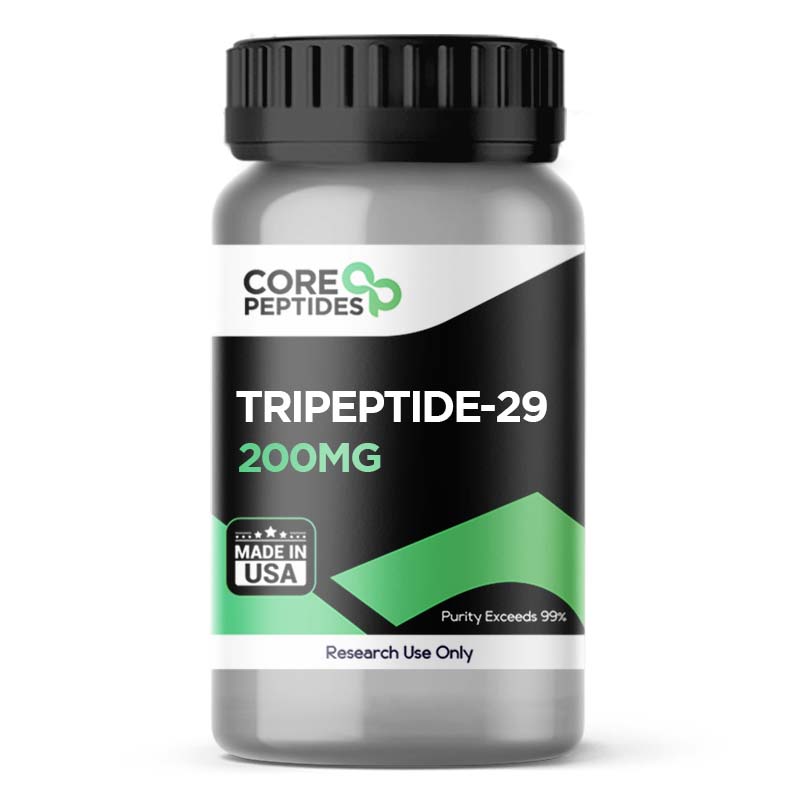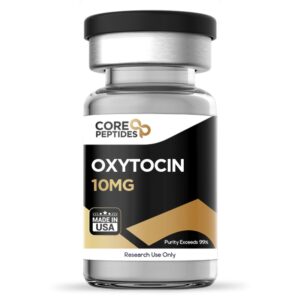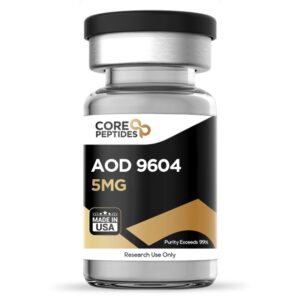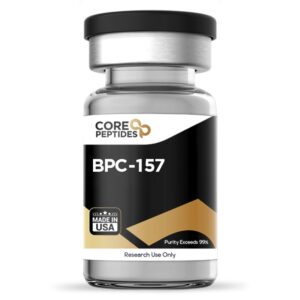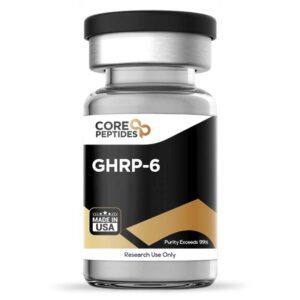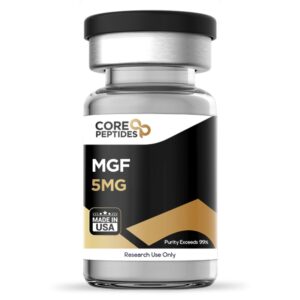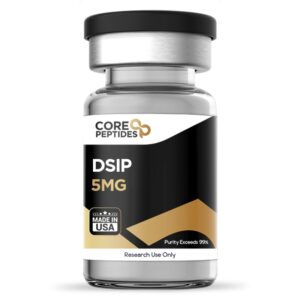Tripeptide-29 (200mg)
$176.00
Size: 200mg
Contents: Tripeptide-29
Form: Lyophilized powder
Purity: >99%
SKU: P-Tripeptide-29
FREE Shipping on $200+ orders
Discount per Quantity
| Quantity | Discount | Price |
|---|---|---|
| 5 - 8 | 5% | $167.20 |
| 9 + | 10% | $158.40 |
Tripeptide-29
Tripeptide-29 is a small, naturally occurring amino-acid peptide, one of the primary building blocks for collagen protein.(1) Collagen is a major component of the extracellular matrix, the network of proteins and fibers comprising connective tissues. It is considered responsible for providing structure and support to cellular complexes.
Researchers suggest Tripeptide-29 may have the potential to stimulate collagen synthesis and promote the formation of collagen fibers. In addition to its possible role in collagen synthesis, Tripeptide-29 may have other biological functions. For example, research studies have hypothesized its potential as an antioxidant, which might help protect cells from oxidative stress and damage. It may also exhibit anti-inflammatory, anti-fibrotic, and anti-melanogenic characteristics.
Chemical Makeup
Molecular Formula: C12H19N3O5
Molecular Weight: 285.3 g/mol
Other Known Titles: Glycylprolylhydroxyproline
Research and Clinical Studies
Tripeptide-29 and Collagen Integrity
Tripeptide-29 may be a major contributor to the stability of type 1 collagen molecules. Studies suggest that the OH group of Hyp in Tripeptide-29 may contribute to the formation of favorable interatomic interactions.(2) The researchers propose that Tripeptide-29 as a monomer may enhance the stability of collagen and collagen microfibrils. Studies also suggest that the presence of Tripeptide-29 as a part of the sequence in collagen may significantly reduce UV-related damage and lower the degradation rate when exposed to intensive radiation.(3)
A study conducted on dermal fibroblasts reported that hydrolyzed type 1 collagen tripeptides exhibited promising potential in reducing oxidative stress and damage.(4) As previously noted, Tripeptide-29 appears to be the primary tripeptide that forms when hydrolyzing type 1 collagen. The hydrolysate showed potential in reducing the build-up of advanced glycation end products (AGEs), reportedly preventing the production of denatured collagen and lowering levels of reactive oxygen species. The glycation process refers to sugar molecules bonding with proteins, potentially speeding up skin cell aging by altering its mechanical properties and stability. Ultimately, the scientists suggested that tripeptide-29 “might improve [cell aging] phenotypes via the inhibition of glycation and oxidative stress, leading to a delay in cellular aging.” From an in vitro perspective, the study explored the mechanisms underpinning the observed action. It was suggested that Tripeptide-29 may reduce the production of AGEs and denatured collagen while inhibiting the activity of matrix metalloproteinases (MMPs) and enhancing collagen 1 levels in dermal fibroblasts. These results suggest that Tripeptide-29 may mitigate cell aging by preserving collagen integrity and inhibiting processes that degrade the skin matrix. Furthermore, it is indicated that Tripeptide-29 might be linked to its smaller peptide size, which is believed to support its skin penetration and bioavailability.
Tripeptide-29 and Glucose Control
According to researchers, Tripeptide-29 may act as a peptidic inhibitor of dipeptidyl peptidase-IV (DPP-IV) due to its potential to inhibit the hydrolysis of the Pro-Hyp bond.(5) It was considered a moderately competitive inhibitor. The scientists reported that “Gly-Pro-Hyp in the collagen hydrolysates is suggested to be mainly responsible for the DPP-IV inhibition in vitro,” inferring that Tripeptide-29 may contribute to the overall inhibitory action of collagen peptides on DPP-IV. Interestingly, Tripeptide-29 was reportedly not hydrolyzed by DPP-IV, indicating resistance to this specific enzyme. This observation might point to the peptide's stability and efficacy in the presence of this enzyme.
Dipeptidyl peptidase-IV (DPP-IV) is a serine peptidase involved in several biological processes.(6) The enzyme is expressed on the surface of various cell types, including immune cells, epithelial cells, and endothelial cells. It is also apparently found in circulation in the liver, kidney, and intestine tissues. DPP-IV cleaves peptide bonds at the N-terminus of dipeptides, tripeptides, and smaller peptides, but not larger peptides or proteins. This specificity means it may act on various substrates, including hormones, neuropeptides, and chemokines. Some of the substrates of DPP-IV include glucagon-like peptide-1 (GLP-1), glucose-dependent insulinotropic polypeptide (GIP), and peptide YY (PYY), all of which are suggested to be involved in the regulation of glucose homeostasis and energy metabolism.(7) The cleavage of GLP-1 and GIP by DPP-IV may result in rapid inactivation and clearance from circulation. Inhibiting DPP-IV may upregulate the levels of GLP-1 and GIP, which may lead to an increase in insulin secretion, reduction in glucagon levels, lower blood glucose, and decreased appetite.(8)
Tripeptide-29 and Platelet Aggregation
Collagen-related peptides that contain a glycine-proline-hydroxyproline repeat motif are considered to be cross-linked through cysteine residues, which may stimulate platelet aggregation and secretion through glycoprotein VI (GPVI) receptors. GPVI is a platelet receptor that scientists believe to be crucial in blood clotting or hemostasis. It is a transmembrane glycoprotein that appears to be primarily expressed on the surface of platelets, which are blood cells involved in blood clotting. GPVI is a member of the immunoglobulin (Ig) superfamily of proteins, comprised of two subunits called alpha and beta. The alpha subunit is considered to contain the collagen-binding site, while the beta subunit is deemed responsible for signaling within the platelet. When the GPVI receptor binds to collagen, it may trigger a series of events that lead to the activation of platelets and the formation of a blood clot.
Studies suggest that the non-cross-linked form of glycine-proline-hydroxyproline, or Tripeptide-29, may induce tyrosine phosphorylation of the tyrosine kinase Syk and phospholipase C gamma2 (PLCgamma2) in platelets.(9) This may ultimately stimulate platelet aggregation to stop or prevent bleeding. Overall, the researchers report that Tripeptide-29, “present as a repeat motif, is sufficient to activate the platelet collagen receptor GPVI,” and may stimulate the formation of thrombi to prevent excessive bleeding.
Tripeptide-29 peptide is available for research and laboratory purposes only. Please review and adhere to our Terms and Conditions before ordering.
References:
- Wiśniewski, K., Artemowicz, B., Lutostańska, A., Maćkowiak, J., & Koziołkiewicz, W. (1994). Central activity of peptide Gly-Pro-Hyp--the main component of collagen degradation products mixture. Acta neurobiologiae experimentalis, 54(1), 33–38.
- Némethy, G., & Scheraga, H. A. (1986). Stabilization of collagen fibrils by hydroxyproline. Biochemistry, 25(11), 3184–3188. target="_blank" rel="noopener"https://doi.org/10.1021/bi00359a016
- Jariashvili, K., Madhan, B., Brodsky, B., Kuchava, A., Namicheishvili, L., & Metreveli, N. (2012). UV damage of collagen: insights from model collagen peptides. Biopolymers, 97(3), 189–198. https://doi.org/10.1002/bip.21725
- Lee, Y. I., Lee, S. G., Jung, I., Suk, J., Lee, M. H., Kim, D. U., & Lee, J. H. (2022). Effect of a Collagen Tripeptide on Antiaging and Inhibition of Glycation of the Skin: A Pilot Study. International journal of molecular sciences, 23(3), 1101. https://doi.org/10.3390/ijms23031101
- Hatanaka, T., Kawakami, K., & Uraji, M. (2014). Inhibitory effect of collagen-derived tripeptides on dipeptidylpeptidase-IV activity. Journal of enzyme inhibition and medicinal chemistry, 29(6), 823–828. https://doi.org/10.3109/14756366.2013.858143
- Trzaskalski, N. A., Fadzeyeva, E., & Mulvihill, E. E. (2020). Dipeptidyl Peptidase-4 at the Interface Between Inflammation and Metabolism. Clinical medicine insights. Endocrinology and diabetes, 13, 1179551420912972. https://doi.org/10.1177/1179551420912972
- Kieffer, T. J., McIntosh, C. H., & Pederson, R. A. (1995). Degradation of glucose-dependent insulinotropic polypeptide and truncated glucagon-like peptide 1 in vitro and in vivo by dipeptidyl peptidase IV. Endocrinology, 136(8), 3585–3596. https://doi.org/10.1210/endo.136.8.7628397
- Kasina, S. V. S. K., & Baradhi, K. M. (2022). Dipeptidyl Peptidase IV (DPP IV) Inhibitors. In StatPearls. StatPearls Publishing.
- Asselin, J., Knight, C. G., Farndale, R. W., Barnes, M. J., & Watson, S. P. (1999). Monomeric (glycine-proline-hydroxyproline)10 repeat sequence is a partial agonist of the platelet collagen receptor glycoprotein VI. The Biochemical journal, 339 ( Pt 2)(Pt 2), 413–418.
